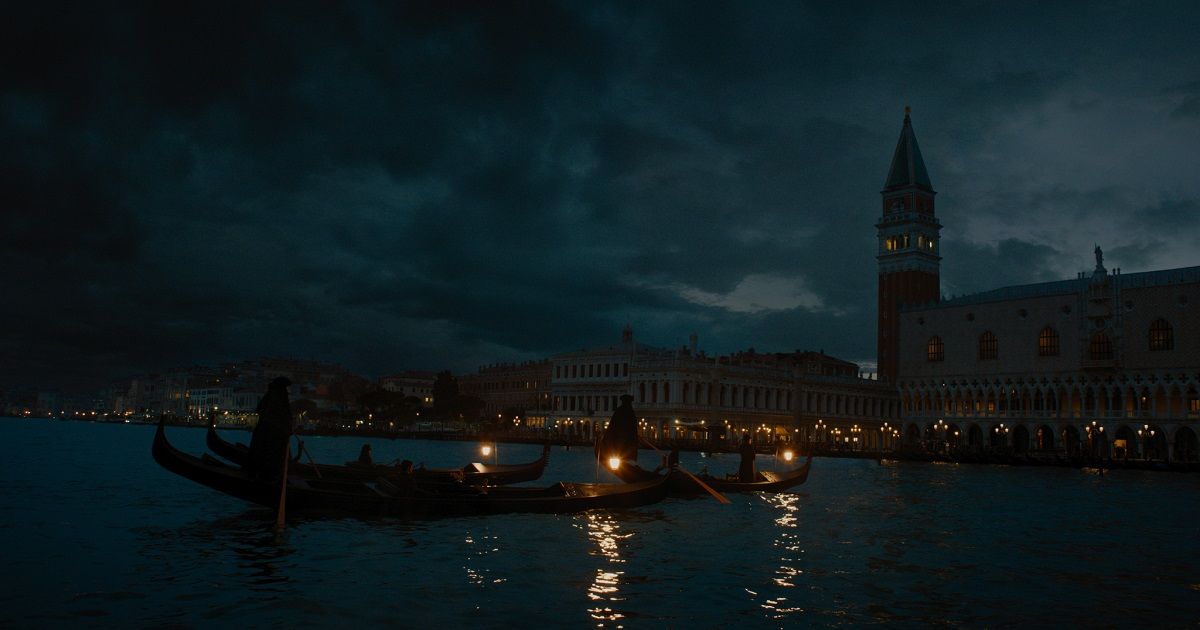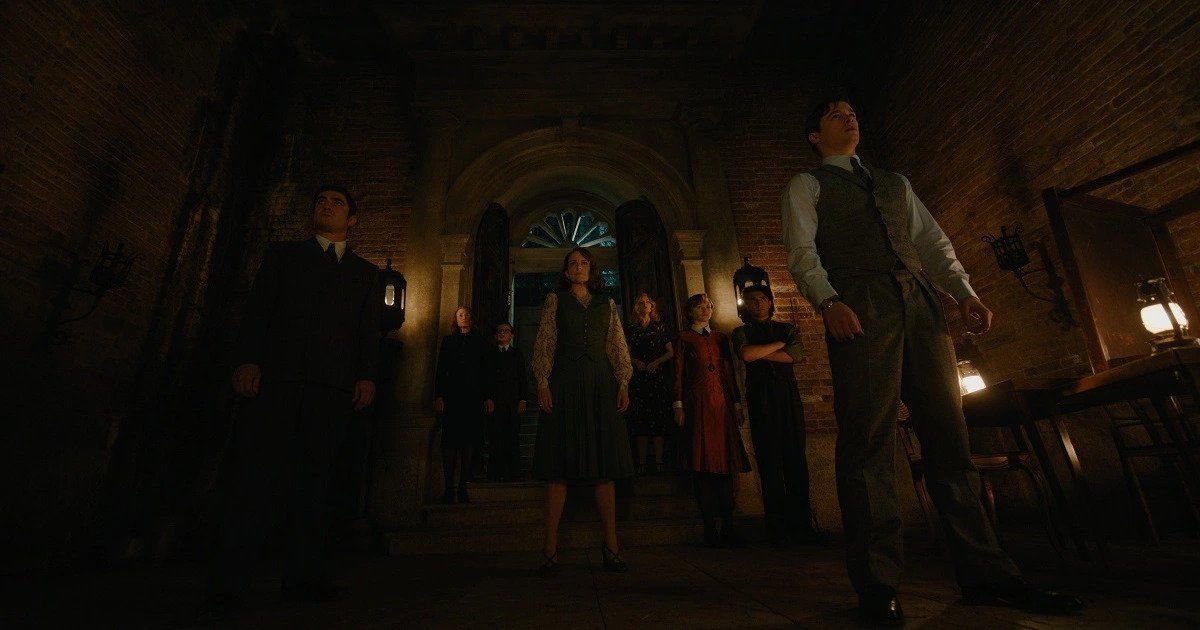A Haunting in Venice marks a dramatic tonal shift from the previous films. Kenneth Branagh's third turn as Hercule Poirot is a terrifying murder mystery with sinister horror elements. A dark premise has the Belgian sleuth trying to discredit a supposed spiritual medium (Michelle Yeoh) at a séance. It takes place inside a creepy palazzo where an opera star's (Kelly Reilly) troubled daughter (Rowan Robinson) took her own life.
A Haunting in Venice looks absolutely stunning. What begins as beautiful and picturesque quickly transitions to grim and frightening. Production designer John Paul Kelly (Operation Mincemeat, The Theory of Everything) "built the exterior and interior of the palazzo in its entirety." He describes Branagh as a "perfectionist" that "wanted to shoot the film unconventionally." Audiences would spend "an hour and a half" in the house, which is a "tall ask" to keep them "entertained and surprised." They didn't want to "fall into the cliché of drippy walls and spooky basements." The house had to be "its own character" that "sat alongside the cast as an equal."
Kelly had "a big technical challenge" but appreciated "the opportunity to celebrate all the amazing palazzos in Venice." He tried "to create different feelings" depending on the "parts of the house." His efforts are clearly evident during the freaky séance and harrowing climax in the flooded basement. Kelly "had a hell of a lot to do in a short time." It wasn't easy with "a little budget" and the fact that "we needed the entire thing to be done for rehearsal." Kelly beamed with pride when recounting "the day that I was able to walk Ken [Branagh] around and know that he was happy."
Read on for our complete interview with John Paul Kelly, and you can watch our video interview above.
Technical Challenges in a Short Timeframe
MovieWeb: A Haunting in Venice is a beautifully staged film. I was really impressed by the set design. Talk about working with Kenneth Branagh and whether there were any difficulties filming in Venice as compared to Pinewood Studios.
John Paul Kelly: Kenneth Branagh, as you probably know, he's a perfectionist. And his character of Poirot, as he plays him, is also a perfectionist. We were interested in creating a very real version of Venice, then somehow interweaving that into the storytelling that was within the script and the Agatha Christie material. Our starting point was spending a lot of time researching palazzos in Venice and going to see them all. We also toyed with the idea of trying to shoot the palazzo in Venice. We realized very quickly that's not going to work, so we built pretty much the entire film. We built the exterior and the interior of the palazzo in its entirety. It does have its technical challenges for the timeframe doing this.
John Paul Kelly: They were big sets. We were working with water, so we built gondolas going into the interior parts of the palazzo. Then we had to build big rooms above the cabana, the top floors, and secret bedrooms. It was a big technical challenge. But in terms of the design, it was a really great opportunity to celebrate all the amazing palazzos that I saw in Venice.
John Paul Kelly: I suppose in terms of storytelling, Ken was very keen we create a space that you can move through, and that the atmosphere will vary. You have almost an hour and a half in one house. That's a tall ask to keep an audience entertained and surprised. We tried to create different feelings depending on which parts of the house, so that it didn't all just fall into the cliché of drippy walls and spooky basements.
John Paul Kelly: You've got cabinets and cathedral-like spaces with fairies and angels looking down from vast heights on the cast below. The idea was to try and create a very interesting kind of emotional space. This house was its own character. It was one of the suspects in the story. It had a kind of prominence that maybe a house doesn't always have in film. Its purpose is really to act as background to help tell the story of the actors and their characters. In this case, it almost sat alongside them as an equal. It could be the guy whodunit [the killer]. That was the idea.
A Complicated Set
MW: What was the best and worst day for you as production designer for A Haunting in Venice?
John Paul Kelly: The best day is when you walk the director on set, and it's complete. It's very unusual, this film, insofar as we needed the entire thing to be done for rehearsal week. That meant all the sets. There were a couple of exteriors we did later, but it was a very tall ask. It was very ambitious. So the day that I was able to walk Ken around and know that he was happy with the set was definitely the best day.
John Paul Kelly: The toughest day, I think, was the realization we had a hell of a lot to do in a short time. We had to really battle with it because of the release dates and very little budget on our first day of photography. We were very tight on getting this across the line and built in time. There were certainly days when I was looking at supervising art director Peter Russell and trying to find out if there was really any way of getting this done. Magic gets pulled out of the hat as it does time and time again. We got it done.
MW: The underground scenes, where they're in the basement and the water is rushing in, was brilliantly staged. Talk about that climactic scene without revealing spoilers.
John Paul Kelly: Ken was very clear right from the beginning that he wanted to shoot the film unconventionally. The camera would be in lots of really unusual positions. There's a structure, you know, tried and tested of how films are shot. You can float ceilings. You can move walls out of the way. We've done this for years. He was really determined that this would be different. When you're inside that palazzo, you were inside and nothing budged. There were huge beam ceilings. The floors are fixed. The walls didn't float. It was a much more solid set than what I would normally get to build, and obviously because of the depth needed in these crumbling walls as well. You just don't get to build flattage and stick some wallpaper on that.
John Paul Kelly: It was a really complicated set with very little movement. It had a different starting point as opposed to other films. But what made it interesting was the same as what interests me in every world I get to create. I love the attention to detail. There are two levels to that. One is being true to the historical accuracy. That's very important, but it's also being true to the storytelling. The flooded basement was our moment to kind of show off what would be like a very traditional horror genre, I suppose.
John Paul Kelly: It was flooded rooms and dolls floating through the water and so on. We played a lot of ideas for that. I think that it worked. Thank you for saying you liked it. It balanced against the kind of prettier spaces that felt threatening in a different way. Alicia's bedroom, for example; we liked the idea of an enchanted forest, and never-ending corridors where somebody could get lost and not be able to find their way back. I think it was keeping a contrast between the spaces that made each one hopefully work.
A Haunting in Venice will have a September 15th theatrical release from 20th Century Studios.


